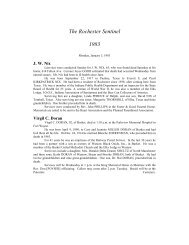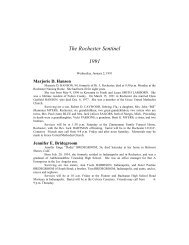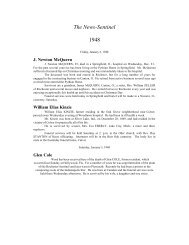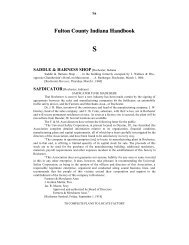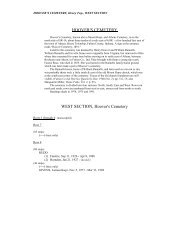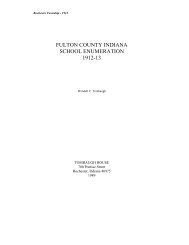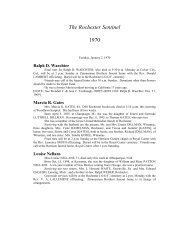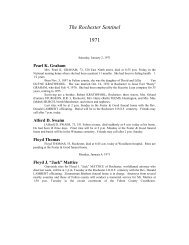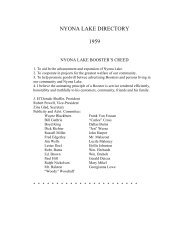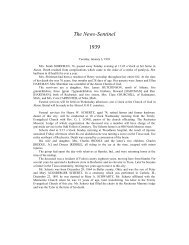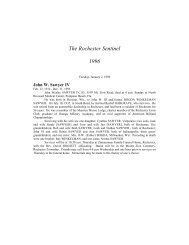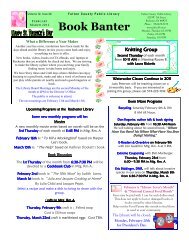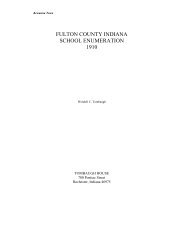Handbook N-P - Fulton County Public Library
Handbook N-P - Fulton County Public Library
Handbook N-P - Fulton County Public Library
You also want an ePaper? Increase the reach of your titles
YUMPU automatically turns print PDFs into web optimized ePapers that Google loves.
Pa<br />
has used his own ideas in constructing the sled and was aided by John Becker and Dick Hart,<br />
blacksmiths.<br />
[Rochester Sentinel, Monday, February 2, 1914]<br />
DESIGNS ENGINE<br />
R. C. Hoffman of Kokomo, son of Mr. and Mrs. F. H. Hoffman, of Argos, and<br />
draughtsman for Haynes Auto Co., has designed a motor which is pronounced by experts to mark<br />
a distinct triumph in mechanical engineering. In fact, it is said, a finished product embracing the<br />
new model is already a reality.<br />
[Rochester Sentinel, Friday, March 15, 1914]<br />
STARTS FACTORY<br />
According to a letter received from Fred True, now in Chicago, he has interested some<br />
capitalists in his puncture proof tire and a factory has been started.<br />
[Rochester Sentinel, Thursday, September 10, 1914]<br />
LOCAL MAN SECURES PATENT<br />
A. H. Boelter, owner of the Rochester Roller Mills, and his two sons, have secured a<br />
patent on an automatic rug and carpet cleaning machine.<br />
Mr. Boelter believes that he has constructed a machine which is far superior to any<br />
apparatus of its kind that has ever been placed upon the market. The machine is 34 feet long and<br />
11 feet wide. The rug to be cleaned is spread upon a wire bed which passes back and forth rapidly<br />
under a spanking apparatus, constructed of leather beaters which will revolve at a great speed. The<br />
beater is followed by a sweeper.<br />
Mr. Boelter says that the machine will take every particle of dirt from the rug, something<br />
that a vacuum cleaner will not do. The machine, when completed, will sell for about $500. Mr.<br />
Boelter has patented several articles which have been a complete success.<br />
[Rochester Sentinel, Friday, November 20, 1914]<br />
INVENTS NEW R.R. TIE<br />
John W. Eiseman, of Kewanna, was a business caller on the division engineer of the Erie<br />
railroad in Huntington recently. Mr. Eiseman recently took out a patent for a concrete tie which he<br />
invented and called to show the advantages of his invention and to push the sale of it.<br />
A number of concrete ties have been invented and tried out by various railroads of this<br />
country, but none of them ever worked out successfully. For this reason the Erie officials are<br />
somewhat doubtful about the value of the invention. Eiseman said, however, that it might prove<br />
successful if given a try out.<br />
The greaatest trouble with the concrete tie is that it cannot stand the continuous pounding<br />
of car wheels without crumbling up. It is also apt to crack and weaken during heavy frosts and so<br />
forth, and for these reasons is not practicable.<br />
[Rochester Sentinel, Wednesday, December 16, 1914]<br />
TRUE PATENTS TIRE<br />
Fred True of Chicago spent Sunday with relatives here. He is trying to interest local<br />
capital in a puncture proof tire which he wants to manufacture here. This tire has been examined<br />
by many automobile companies and they will place orders with True, if he is able to make them<br />
the goods.<br />
[Rochester Sentinel, Monday, March 22, 1915]<br />
NEW TIRE DEVICE<br />
Dr. Barker of Kewanna, expert veterinary-dentist, has perfected a coil spring device for<br />
innsertion inside auto tire casings to take the place of air and has asked for a patent.<br />
[Rochester Sentinel, Wednesday, March 24, 1915]




